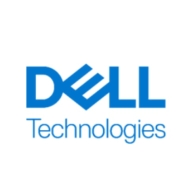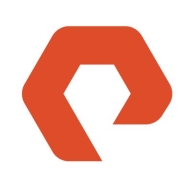

Dell Unity XT and Pure FlashArray X NVMe are two competitive storage solutions. Dell Unity XT has the upper hand in pricing and support, while Pure FlashArray X NVMe excels in advanced features and long-term ROI.
Features: Dell Unity XT highlights strong integration capabilities, robust data protection, and solid reliability. Pure FlashArray X NVMe garners praise for high performance, efficient data reduction, and superior speed. Both products offer enterprise-grade features for demanding storage needs.
Room for Improvement: Dell Unity XT users suggest improved scalability, enhanced analytics, and faster performance. Pure FlashArray X NVMe users desire better support, reduced cost barriers, and easier integration. These improvements can enhance the user experience for both products.
Ease of Deployment and Customer Service: Dell Unity XT deployment is straightforward, with users noting good customer support. Pure FlashArray X NVMe receives mixed reviews on deployment ease but higher ratings for customer service efficiency. Dell Unity XT's setup simplicity contrasts with Pure FlashArray X NVMe's strong post-deployment support.
Pricing and ROI: Dell Unity XT is noted for more affordable setup costs and immediate ROI. Pure FlashArray X NVMe, though more expensive, delivers superior long-term ROI through advanced efficiencies. Dell Unity XT's cost-effectiveness is significant, while Pure FlashArray X NVMe offers value over time.
By opting for the gold subscription every three years, you get a free upgrade to the latest controller release.
If you wait more than seven years to buy another one, you get a return on your investment.
The support team is familiar with the product and is available on-site during support times, which improves our experience.
Dell solutions are backed by excellent service and support.
The technical support sometimes takes three to four days to get hardware to facilities.
We also had one outage where a controller of one of the products had failed and had to be replaced on-site.
Customers always have their issues resolved promptly.
Pure has good storage.
Dell Unity XT is quite scalable and can be scaled up to the petabyte level.
For NetApp, we can recommend the FAS 8000 series.
It is highly scalable.
It is suitable for both medium-sized and enterprise businesses.
It hasn't broken down anytime in the last six to seven years, despite hurricanes, earthquakes, and power outages.
I would rate the overall stability of Dell Unity XT an eight out of ten.
During the eight years, there have been no problems such as hardware failure or stopping.
I would rate the stability of the solution as a ten out of ten.
I would rate the stability of the product at seven out of ten.
In the future, if Dell storages include this option, especially for Unity, it would help us target SME or medium enterprises for quicker closures and support the sales team.
I believe if Dell can integrate AI to predict potential failures, especially in hardware like hard disks, that would be very useful for proper maintenance.
The pricing is a bit higher than expected.
We would appreciate a built-in transparent failover in the next release to eliminate the need for a separate metro cluster.
I'm eagerly anticipating the roadmap's promise of introducing multiple controllers, which could significantly boost scalability and resilience.
We mostly rely on long-term releases. We don't need the most up-to-date features, but we need a reliable environment.
It is priced at around or under $50,000.
The cost is not cheap nor expensive.
Commercially, Dell Unity XT is viable and competitively priced.
While the prices may be higher than those of other vendors, we see it as a market leader with benefits.
The support can be a bit pricey, but the solution is more cost-effective than anything else out there.
I would give it a nine out of ten in terms of costliness.
It helps with data cost management and is seen as a mid-range product with good performance.
We installed the Flash, which makes our IO operations fast and efficient.
If their growth is not significant, we might suggest mid-level Unity storage like Unity 300.
Pure Storage has signature security technology, which cannot be deleted, even if you are an administrator.
The platform's robust features include excellent sustainability tracking, and a comprehensive dashboard offering insights into IOPS, bandwidth, performance, and virtual activities.
Its data compression feature is the best that we have ever seen.
| Product | Market Share (%) |
|---|---|
| Dell Unity XT | 6.3% |
| Pure FlashArray X NVMe | 1.0% |
| Other | 92.7% |


| Company Size | Count |
|---|---|
| Small Business | 61 |
| Midsize Enterprise | 49 |
| Large Enterprise | 94 |
| Company Size | Count |
|---|---|
| Small Business | 15 |
| Midsize Enterprise | 11 |
| Large Enterprise | 12 |
Dell EMC Unity XT is one of the best all-flash storage arrays on the market today. Dell EMC Unity XT arrays are designed for performance, optimized for efficiency, and built for a multi-cloud world. In addition, they support digital transformation, enabling businesses to reach the full potential of their data capital quickly and easily. Dell EMC Unity’s All-Flash and Hybrid Flash storage platforms provide the performance, efficiency, enterprise-class software, and virtualization integrations required for running a wide range of virtualized applications.
Dell EMC Unity XT Features
Dell EMC Unity XT has many valuable key features, including:
Dell EMC Unity XT Benefits
Some of the benefits of using Dell EMC Unity XT include:
Reviews from Real Users
Below are some reviews and helpful feedback written by Dell EMC Unity XT users.
A Systems Engineering Manager at a manufacturing company says, "It is definitely one of the most robust, solid, well-performing products that I have dealt with. It is set it and forget it, which is pretty amazing." He also mentions, “We can do both block and file storage on one unit without purchasing a separate device.”
Peter S., Senior Technical Specialist at a healthcare company, states, “The most valuable feature is reliability. At the end of the day, it just runs. This solution is easy to work with and easy to maintain.”
PeerSpot user Melvin T., Senior Systems Engineer at Prosperity Bank, explains that the solution is “easy to use and we can add LUNs or space without interruption to end-users. We're able to access it from just about anywhere, as long as we have access to a browser. That feature is really neat because sometimes we will go to a different data center or a different site, and if we need to access it to see a LUN or to see any type of storage, we can do that. That's one of the big takeaways with Unity."
Pure Storage FlashArray//X is the world’s first enterprise-class, all-NVMe flash storage array. It represents a new class of storage – shared accelerated storage, which is a term coined by Gartner – that delivers major breakthroughs in performance, simplicity, and consolidation.
We monitor all All-Flash Storage reviews to prevent fraudulent reviews and keep review quality high. We do not post reviews by company employees or direct competitors. We validate each review for authenticity via cross-reference with LinkedIn, and personal follow-up with the reviewer when necessary.